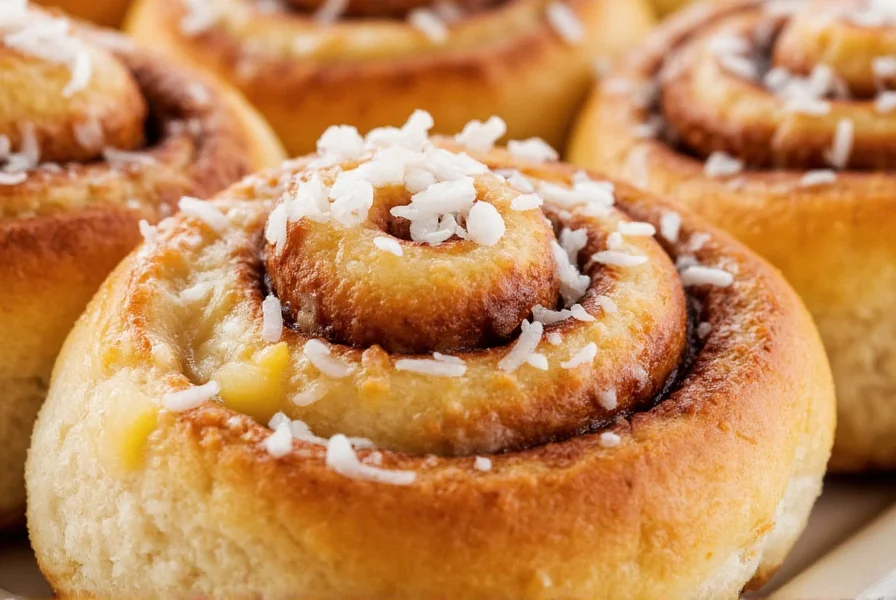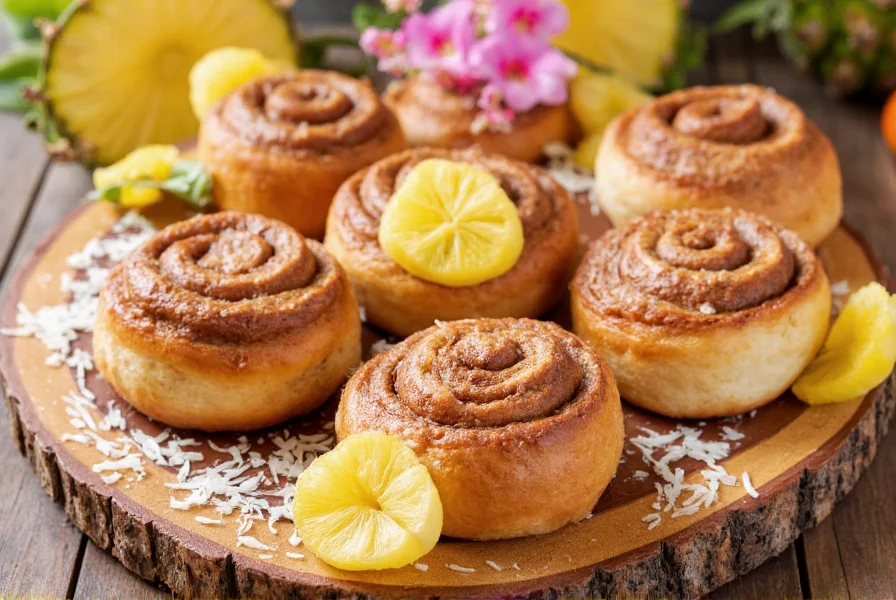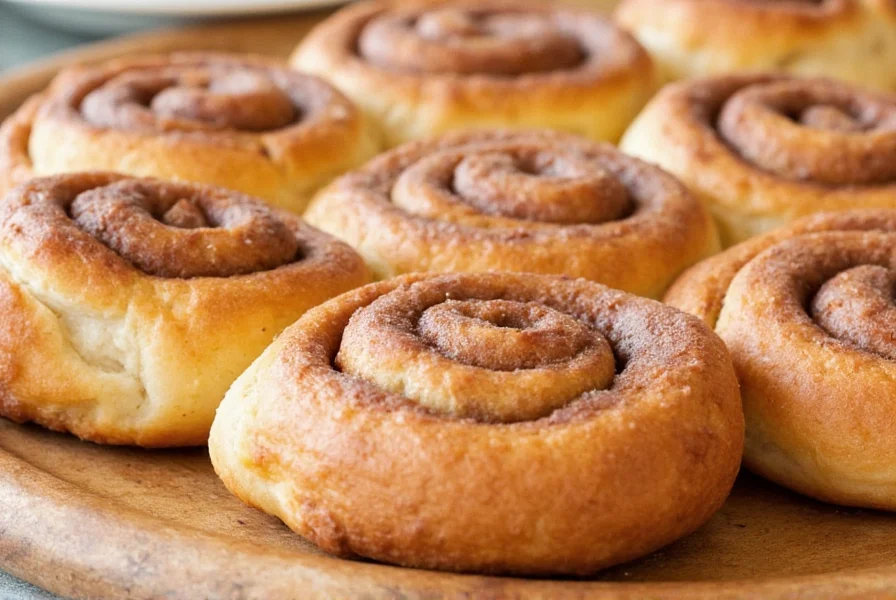What transforms ordinary cinnamon rolls into Hawaiian-style treats? The magic lies in specific tropical additions that elevate both flavor and texture. While recipes vary across Hawaii and mainland adaptations, authentic versions consistently feature pineapple as the signature ingredient. This isn't just a random addition—it's a nod to Hawaii's agricultural heritage where pineapple cultivation has been central since the early 20th century.
The Defining Elements of Hawaiian Cinnamon Rolls
Understanding what makes these rolls special requires examining their key components. Traditional Hawaiian cinnamon rolls differ from standard versions through three critical elements:
| Element | Traditional Cinnamon Rolls | Hawaiian Cinnamon Rolls |
|---|---|---|
| Signature Ingredient | Plain dough with cinnamon-sugar filling | Crushed pineapple incorporated into dough or filling |
| Texture Profile | Rich, buttery, dense | Noticeably moister with tender crumb |
| Flavor Complexity | Sweet with warm spice notes | Balanced sweet-tart with tropical undertones |
Essential Ingredients Breakdown
Creating authentic Hawaiian cinnamon rolls requires attention to specific ingredients that contribute to their distinctive character. While the base dough resembles traditional cinnamon roll recipes, the additions transform the final product.
Pineapple serves as the cornerstone ingredient. Most bakers use crushed pineapple (well-drained) added directly to the dough. The natural enzymes in pineapple tenderize the gluten, resulting in an exceptionally soft texture. The fruit's acidity also balances the sweetness, preventing the rolls from becoming cloying. For best results, many Hawaiian bakeries use locally grown varieties like Smooth Cayenne.
Coconut appears in many authentic recipes, either as toasted flakes in the filling or incorporated into the glaze. This addition pays homage to another Hawaiian agricultural staple. When using coconut, opt for unsweetened flakes toasted until golden for maximum flavor without excess sweetness.
Macadamia nuts feature in some regional variations, particularly on the Big Island. These rich, buttery nuts complement the pineapple beautifully when finely chopped and sprinkled over the filling before rolling.

Step-by-Step Preparation Guide
Mastering Hawaiian cinnamon rolls requires attention to specific techniques that accommodate the unique ingredients. Follow these steps for bakery-quality results:
- Prepare the pineapple: Drain crushed pineapple thoroughly—press between paper towels to remove excess moisture. This prevents soggy dough while retaining flavor.
- Mix the enriched dough: Combine yeast, warm milk, sugar, and melted butter. Add pineapple, eggs, and flour gradually until a soft dough forms.
- First rise: Let dough rise in a greased bowl until doubled (about 1.5 hours). The pineapple enzymes will create a more delicate rise than traditional dough.
- Create the filling: Mix brown sugar, cinnamon, and melted butter. For authentic Hawaiian flavor, add 2 tablespoons of toasted coconut.
- Roll and cut: Roll dough into a 16x12 inch rectangle. Spread filling evenly, leaving ½ inch border. Roll tightly and cut into 12 pieces.
- Second rise: Place rolls in greased pan, cover, and let rise until puffy (45-60 minutes).
- Bake: At 350°F for 22-25 minutes until golden brown. The pineapple creates steam that keeps rolls exceptionally moist.
- Glaze: While warm, drizzle with cream cheese or coconut glaze.
Avoiding Common Baking Mistakes
Even experienced bakers encounter challenges with Hawaiian cinnamon rolls. Understanding these pitfalls ensures perfect results:
- Insufficient pineapple drainage: Excess moisture creates dense rolls. Always press pineapple between multiple layers of paper towels for 5 minutes.
- Over-rising: The pineapple enzymes accelerate fermentation. Check dough after 60 minutes—even if not fully doubled, proceed to rolling.
- Incorrect cutting technique: Use unflavored dental floss instead of knives for clean cuts that don't compress the dough.
- Glazing too early: Wait 10 minutes after baking before applying glaze to prevent sogginess while allowing absorption.
Variations for Different Preferences
Hawaiian cinnamon rolls adapt beautifully to various dietary needs while maintaining their distinctive character:
- Gluten-free version: Substitute with 1:1 gluten-free flour blend and add ½ teaspoon xanthan gum. Reduce pineapple to ⅓ cup to prevent excess moisture.
- Vegan adaptation: Replace dairy with coconut milk, use vegan butter, and substitute eggs with flax eggs (1 tbsp ground flax + 3 tbsp water per egg).
- Reduced sugar option: Decrease filling sugar by 25% and use pineapple packed in juice (not syrup). The fruit's natural sweetness compensates for reduced added sugar.

Serving and Storage Recommendations
Hawaiian cinnamon rolls deliver peak flavor when served warm, but their unique moisture content affects storage compared to traditional versions. The pineapple creates a more perishable product that requires specific handling.
For immediate serving, allow rolls to cool 10 minutes before glazing. The residual heat helps the glaze melt into the swirls without making them soggy. Pair with Kona coffee or passion fruit juice for an authentic Hawaiian breakfast experience.
When storing leftovers, place in an airtight container at room temperature for up to 24 hours. The pineapple content means refrigeration becomes necessary after this point—unlike traditional cinnamon rolls which keep well at room temperature for several days. To refresh, microwave individual rolls for 10-15 seconds or warm in a 300°F oven for 5 minutes.
Frequently Asked Questions
What makes cinnamon rolls Hawaiian instead of regular?
Hawaiian cinnamon rolls incorporate pineapple—typically crushed and well-drained—into the dough or filling. This addition creates a distinctive moist texture and subtle sweet-tart flavor that differentiates them from traditional versions. Many authentic recipes also include coconut or macadamia nuts as secondary tropical elements.
Can I use canned pineapple for authentic Hawaiian cinnamon rolls?
Yes, well-drained canned crushed pineapple works perfectly for Hawaiian cinnamon rolls. In fact, most Hawaiian bakeries use canned pineapple for consistent moisture content and year-round availability. Just be sure to drain thoroughly and press between paper towels to remove excess liquid before incorporating into the dough.
Why do my Hawaiian cinnamon rolls come out too dense?
Density typically results from insufficient pineapple drainage or over-rising. The enzymes in pineapple tenderize gluten, but excess moisture prevents proper structure. Always press pineapple between paper towels for 5 minutes. Additionally, pineapple accelerates fermentation—check dough after 60 minutes rather than waiting for full doubling.
How long do Hawaiian cinnamon rolls stay fresh?
Due to the pineapple content, Hawaiian cinnamon rolls have a shorter shelf life than traditional versions. They stay fresh at room temperature for 24 hours, then require refrigeration. For best quality, consume within 3 days. The moisture from pineapple makes them particularly perishable compared to standard cinnamon rolls.











 浙公网安备
33010002000092号
浙公网安备
33010002000092号 浙B2-20120091-4
浙B2-20120091-4